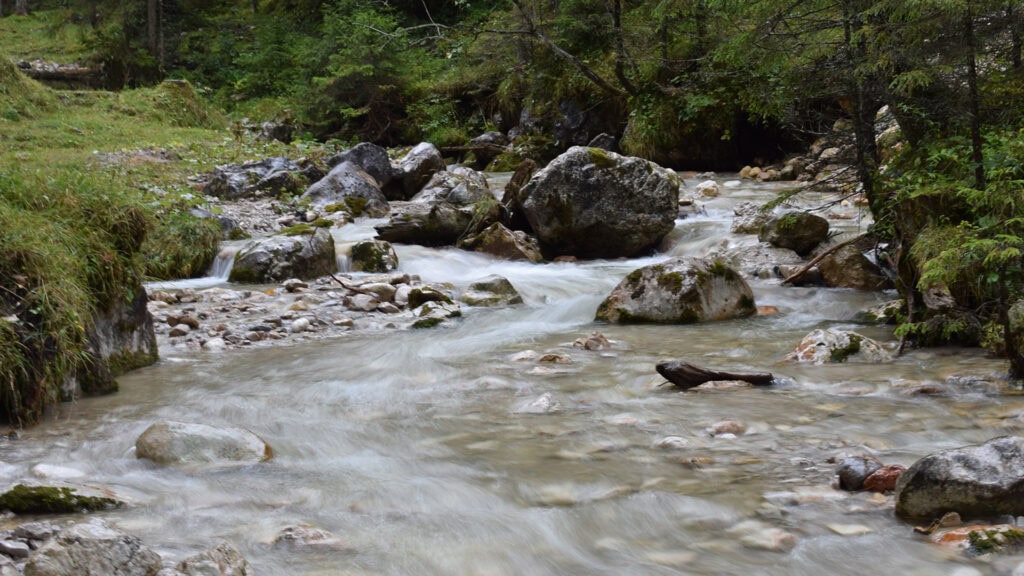The water that flows downstream through the Eggenbach has completed a long journey through the mountain massif. It originates from the area above the Weitengraben, between Gschöllkopf, Rotspitz, and Hochiss. There, two deep channels shape the alpine terrain that forms the catchment area of the Eggenbach and the Weitenbach.
A catchment area includes the land surfaces where precipitation and snowmelt infiltrate the ground and eventually feed the stream. The water percolates underground through the rock and finally emerges again at the spring.
But how is it possible for water to travel through rock?
The type of rock determines whether and how water flows underground. Different rock layers have different abilities to store or transmit water. Some rocks act as impermeable barriers, while others—with many pores or cavities—can conduct water well.
The source of the Eggenbach
At the source of the Eggenbach, two types of rock meet: The so-called Kössen Formation below the spring consist of dense, fine-grained marl limestone and are impermeable to water. Above them lies the Upper Rhaetian Limestone, which, due to fissures and cavities in the rock, conducts water well (this is known as an aquifer or groundwater reservoir). At the contact zone between the impermeable layer and the water-bearing layer, the water emerges at the surface.

The Mountain – A Natural Water Reservoir: Precipitation infiltrates the rock in the catchment area, where it is naturally filtered and enriched with minerals. The Upper Rhaetian Limestone acts as an aquifer, allowing water to pass through its porous structure. In contrast, the marl layers of the Kössen Formation are impermeable, forming a barrier that traps water. At the contact zone between these two rock types, groundwater emerges at springs—such as the one here at the Eggenbach. (Image source: Own illustration)
Water-Bearing Rocks – Aquifers
A water-bearing rock layer is called an aquifer if it can absorb, transmit, or store water. Such aquifers can have either geochemical or mechanical origins. In the first case, we speak of karst aquifers. Water enriched with carbonic acid dissolves limestone, forming underground channels and cave systems through which the water is transported inside the mountain. You can learn more about this chemical dissolution process here (station: Karst and its Formation). But not all groundwater comes from limestone.
Fracture aquifers are independent of the chemical composition of the rock. Here, the mechanical stress on the rock plays a key role. Tectonic forces create cracks and fractures in the rock. Water flows through the rock along these fissures. Often, there are combinations of fracture and karst systems, as is the case at the Eggenbach.
The properties of the subsurface determine how much precipitation runs off at the surface, infiltrates into the ground, or is stored. This directly influences the groundwater system.
The residence time of water underground varies greatly—it can range from a few hours to several decades, depending on the characteristics of the aquifer. Deep within the mountain, groundwater is filtered through the rock under cool conditions. On its journey through the rock, it absorbs minerals from the surrounding material.
In Austria, about one third of the available water comes from groundwater bodies. Impressively, nearly 100% of Austria’s drinking water is sourced from groundwater and spring water. In the Alpine region, groundwater is known for its particularly high quality.
Did you know that the average Austrian uses around 130 liters of drinking water per day? (Bundesministerium für Land- und Forstwirtschaft, Regionen und Wasserwirtschaft k.A.)

